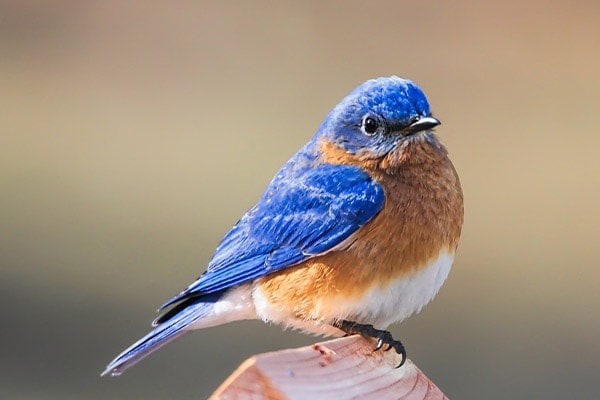
photo credit: Naturelady from Pixabay
The Eastern Bluebird is a lovely songbird widespread in the eastern United States. Their bright blue and brick-red color pattern is easily recognizable, making them just a beautiful scene to look at. They love to stay in open areas where there are lots of trees around. So, if you have lots of trees and shrubs in your backyard and have the right food they love, there’s a high chance you can attract them.
In this article, we are going to cover a wide variety of topics related to the Eastern Bluebird, such as:
- How to identify them
- How, when, and where they migrate
- Their diet
- How and where they nest
- And much more…
So, without any more delay…
Let’s jump right into it and learn more about the Eastern Bluebird.
Eastern Bluebird Facts
- Common Name: Eastern Bluebird
- Scientific Name: Sialia sialis
- Scientific Family: Turdidae
- Life Span: 6-10 years
- Size: 6.3 to 8.3 inches
- Wingspan: 9.8 to 12.6 inches
- Weight: 1.0 to 1.1 oz
- Conservation status: Least Concern
How To Identify A Eastern Bluebird
The Eastern Bluebird is a small songbird with a size bigger than a sparrow but smaller than a robin. They usually have a big and round head, large eyes, and round bodies. They have a short bill, legs, and tail, with slightly extended wings.
The color pattern is a combination of bright blue back, rusty breast, and white abdomen. Another thing that you’ll notice with these birds is they always stand upright.
Differences Between Male & Female
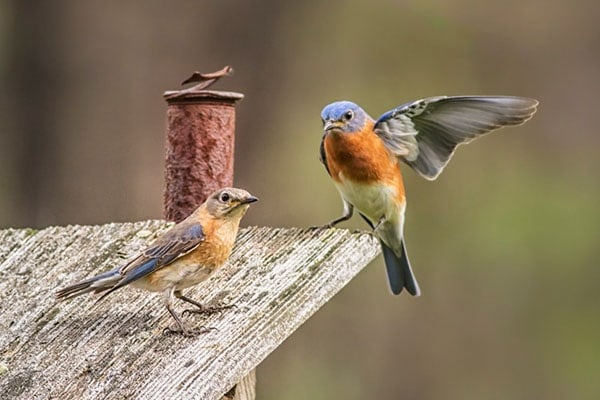
photo credit: Dulcey Lima on Unsplash
It’s easy to identify a male Eastern Bluebird from the female one, based on the color pattern. Male Eastern Bluebirds feature clear, bright blue colors on the head, back, and wings, a brick-red color in the throat and chest areas, and white underparts.
Female Eastern Bluebirds, on the other hand, have duller colors than the males. Their head, back, and wings show a bluish-gray color, the chest and throat areas are orange-brown, and pale gray underparts.
Differences In Summer Plumage vs Winter Plumage
Eastern Bluebirds don’t show any changes in their color patterns throughout the year.
Eastern Bluebird Sounds
Where You’ll See Eastern Bluebirds
As the name implies, Eastern Bluebirds are mainly found in the eastern part of the United States, with their range extending south to Nicaragua. The birds usually stay in open country areas, sparse woodlands, and woodland edges. They are also often seen in parks, gardens, pastures, agricultural fields, golf courses, and even your backyard.
Eastern Bluebird Migration Patterns
Eastern Bluebirds are considered resident to medium-distance migratory birds. Those from the southeastern United States mainly stay in the same place year-round. However, others decide to move a short distance going south.
When the breeding season starts, some Eastern Bluebirds fly north to southern Canada. Northern populations of Eastern Bluebirds are migratory, and they usually fly to the southeastern United States or Mexico for winter. Some even fly further, going to Texas and Colorado.
Diet and Feeding Preferences
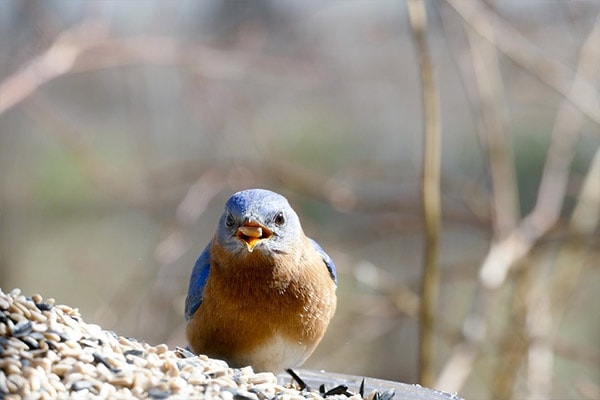
photo credit: DaveUNH from Pixabay
Eastern Bluebirds, like many other birds, eat various foods depending on the season. They eat insects for most of the year, making up to 68% of their diet. Among their favorite insects to eat are caterpillars, beetles, grasshoppers, worms, and spiders. They also sometimes eat small amphibians and lizards, but this is very rare.
During the fall and winter seasons, the birds eat fruits and other plant materials because insects are hard to find. Their diet would usually include mistletoe, sumac, blackberry, blueberries, honeysuckle, huckleberries, and many more.
Nesting Data
- Clutch Size: 2-7 eggs
- # of Broods: 1-3 broods
- Incubation Period: 10-15 days
- Nestling Period: 9-12 days
- Egg Description: Light Blue or White with black or brown spots
Nesting
Eastern Bluebirds mate around spring and summer. Their typical nest site is in natural cavities of trees, a woodpecker hole, or sometimes a birdhouse. One of the deciding factors for these birds is that the nest site should be safe, so they usually choose nest sites up to 50 feet high up from the ground.
Male Eastern Bluebirds attract the females by bringing materials in and out of the hole. After that, the female would be the one that builds the nest.
Female Eastern Bluebirds use grasses and pine needles as construction materials. She weaves these together and lines the nest with fine grasses, animal hair, and feathers. It usually takes them 17-21 days to finish the nest that forms a shape of a cup.
Eastern Bluebird Behavior
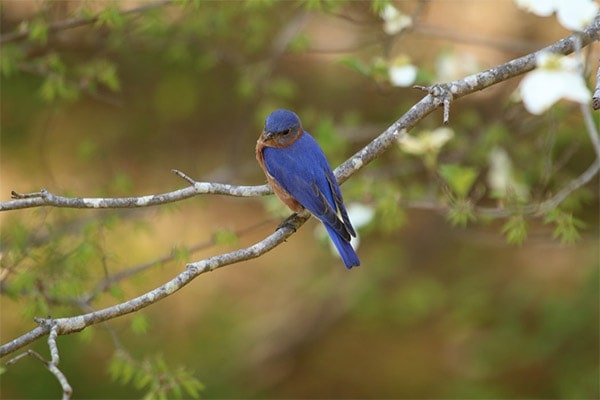
photo credit: MICHAEL MURPHY on Unsplash
Eastern Bluebirds are social birds that usually gather in flocks reaching up to 100 hundred or more. But, they can be very territorial, too, when it comes to their nesting and feeding territories.
They are often seen perching on wires and fences in open fields, searching for prey 60 feet away or more. Once these birds find something, they fly to the ground to get it. Sometimes, they even manage to catch insects midair.
Tips for Birdwatchers On How To Attract Eastern Bluebird
When it comes to attracting Eastern Bluebirds, or any bird, in particular, it’s essential to meet all of their needs. So, try to figure out what they like in terms of food and shelter.
Eastern Bluebirds love open spaces with lots of short grass, shrubs, and trees around. And since these birds eat lots of insects, you should refrain from using pesticides to drive the insects away. After all, these birds will be the ones who will take care of those pests.
You can then plant some plants that bear berries like American elderberry blueberries, holly, eastern red cedar, and many more. If you want to set-up feeders, place some Mealworms in there or Suet so they will visit.
You’ll also want to provide perches for these birds so they can look for insects better. You can also build them a high-quality nest box, but be sure to place them at least five to six feet off the ground.
Lastly, provide a birdbath or fountain where the birds can drink or bathe. Be sure to change the water from the birdbath frequently, and the water should only be shallow.
Threats To The Eastern Bluebird
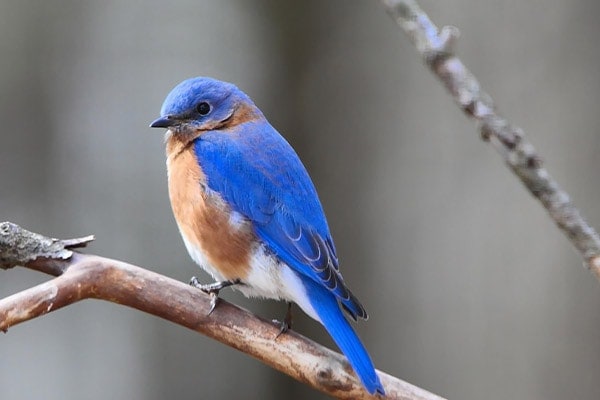
photo credit: Naturelady from Pixabay
There was a massive decline in the Eastern Bluebird population around the early 20th century as there were lesser habitats for them. Fortunately, due to conservation efforts such as establishing trails and building nest boxes for the birds, their numbers have recovered and increased.
Now, predators are the only threat to the birds. Chipmunks and squirrels often target eggs and nestlings, while house sparrows, snakes, black bears, raccoons, fire ants, and cats often target adult Eastern Bluebirds and fledglings.
Fun & Interesting Facts
- The Eastern Bluebird is the official bird of the states of Missouri and New York.
- These birds are also known as the American Bluebird, Wilson’s Bluebird, and Common Bluebird.
- They were once declared as a rare species in the year 1976 to 1978.
- Male Eastern Bluebirds don’t open their beaks when singing.
- Their bird call sounds like the word “truly”.
- North American Bluebird Society was formed in 1978 to encourage the building of bluebird nest boxes to save the declining population of Eastern Bluebirds.
- They are symbols of spring, happiness, love, and hope.
- The oldest Eastern Bluebird recorded is ten years and six months old.
Explore More Species in This Family
- Western Bluebird
- Mountain Bluebird
- Townsend’s Solitaire
- Varied Thrush
- Veery
- Gray-cheeked Thrush
- Bicknell’s Thrush
- Swainson’s Thrush
- Hermit Thrush
- Wood Thrush
- American Robin
The post Eastern Bluebird: Bird Identification, Habits, Facts, Nesting appeared first on BirdInformer.com.
from BirdInformer.com https://ift.tt/3cpLNaX

No comments:
Post a Comment